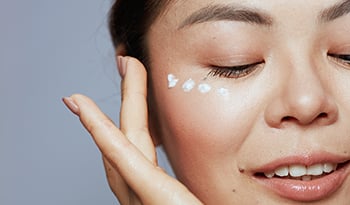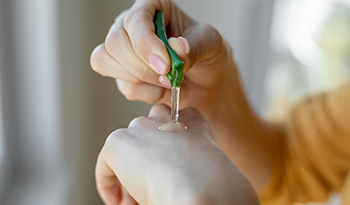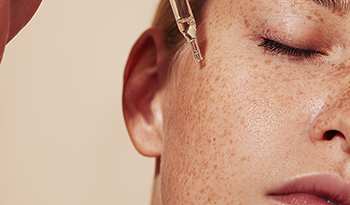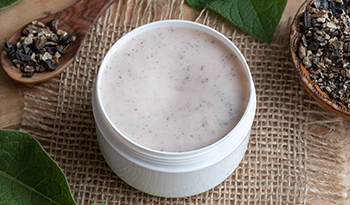How to Incorporate Ayurvedic Principles in Your Oral Care Routine

Did you know you can use Ayurvedic Principles in your oral care routine? Ayurveda is an Indian traditional medicinal healing practice dating back more than 5000 years. It is now practiced in other parts of the world as complementary medicine. Ayurveda focuses on creating a balance between the mind, body, and spirit. Oral situations such as deformities of the oral cavity, plaques, and infections can be managed by using Ayurveda.
So, what Ayurvedic principles can we use in oral routines? Well, Ayurveda mouth care concentrates on cleaning the mouth properly and using natural and herbal products. Oil pulling, using twigs or chewing sticks, and tongue scraping are some Ayurvedic practices for mouth care. Plants you’ve likely already heard of—like turmeric, clove, and licorice root, plus some you are likely less familiar with, like Amla, and hawthorn berry—help stabilize and strengthen oral health, reduce cavities or plaque, and have antibacterial effects, and are used in Ayurvedic practices.
Chewing Sticks
Ayurveda practice focuses on using chewing sticks in the morning and even after meals to prevent diseases. The chewing sticks should be obtained from fresh, healthy, soft stems without leaves or knots and taken from a healthy tree. Stems from specific plants like Licorice (Glycyrrhiza glabra), Margosa tree or Neem (Azadirachta indica), Black Catechu or the Cutch tree (Acacia catechu linn), fever nut, milkweed plant can be used as chewing sticks.
Though it sounds puzzling how to use a stem from a plant, it’s easy to do. The primary method is to crush one end of the stick, chew it and eat it slowly. Neem is the most-used kind of stick as it possesses antimicrobial properties. Chewing on it releases antibacterial agents, which mix with saliva and kill harmful microbes in the mouth, thereby preventing the accumulation of bacteria on the teeth and strengthening the gums. Chewing on these stems can also cause attrition and leveling of biting surfaces, facilitate salivary secretion and possibly, help in plaque control.
Oil Pulling
Oil pulling is a procedure that involves swishing oil in the mouth for oral and systemic health benefits. This technique helps remove harmful bacteria from your teeth and gums. In addition, it is very effective against plaque-induced gingivitis. This can be done by using oils like sunflower oil, coconut oil, or sesame oil. Here are some of the benefits of oil pulling:
- Eradicates plaque
- Rebuilds enamel
- Whitens the teeth
- Eliminates harmful bacteria
- Reduces inflammation
- Freshens the breath
- Strengthens the gums
It can be practiced as part of your morning routine. You take a spoonful of oil and swish it in your mouth for 10–20 minutes so that your teeth get a good coating of the oil. Remember not to swallow the oil and spit it out after swishing. After this, rinse your mouth gently with hot water, followed by brushing your teeth.
Tongue Scraping
Even if you are brushing your teeth, or flossing, your tongue can harbor bacteria that are responsible for bad breath, tooth decay, and gum infections. Cleaning the tongue in the morning with a tongue cleaner has been an ayurvedic tradition for thousands of years, and this simple method has been confirmed effective by numerous studies. For example, a Toronto study found that cleaning the tongue reduces putrid gasses and bad breath by about 75%, whereas usual teeth cleaning only produces a reduction of about 25%. According to the physicians’ association of North Rhine, tongue cleaning could, like brushing your teeth, help to reduce the risk of caries and support dental health.
Here is how you can try tongue scraping at home:
- First, you will need a tongue cleaner.
- Grip the ends of the tongue cleaner with both hands and hold it in a horizontal position.
- Place the curved part on the base of the tongue and gently pull over the tongue a few times from back to front.
- Rinse the mouth with a bit of water and rinse the tongue cleaner under running water.
You can do this process every day in the morning or at night after brushing your teeth. Just do not forget to deep clean your tongue cleaner regularly. Take a salt-dipped lemon wedge and clean your tongue cleaner carefully at least once a week.
Turmeric
Studies have been done on turmeric and it has been discovered that people who use 0.1% turmeric extract in mouthwash twice a day experienced a significant reduction in plaque, gingivitis, and bacterial growth when compared to traditional mouthwash. The main active ingredient in turmeric, curcumin, has antiseptic, anti-inflammatory, antimicrobial, astringent, and antioxidant properties. In addition, it prohibits plaque build-up and gingivitis and reduces pain associated with any dental discomfort.
Clove
Clove oil has long been applied directly to the gums to ease toothache. It is researched that Eugenol, a main active component in clove, gives this herb its analgesic and anesthetic properties and it’s also effective at fighting several known harmful oral bacteria including Helicobacter pylori bacteria that promote stomach ulcers, thus maintaining a healthy mouth biome. In short, clove is excellent for relieving pain associated with toothache and inflammation while also maintaining overall oral hygiene.
Triphala
Triphala is a well-rounded herbal formula that consists of the three Indian fruits: Haritaki (Indian Walnut), Amalaki (Indian gooseberry), and Bibhitaki (Terminalia bellirica). Together, these herbs improve digestion, draw impurities from the tissues of the body, regulate excretion/elimination, strengthen the colon, relieve constipation, and provide a healthy dose of Vitamin C to boost immune function. To receive the full benefits of Triphala, classical Ayurveda recommends ingesting Triphala in the form of a churna (powder). Here are some benefits of Triphala:
- Reduces plaque.
- Protects the gums from infections such as gingivitis.
- Removes unhealthy bacteria like lactobacillus and streptococcus mutans, both known to cause tooth decay.
- Heals mouth sores and canker sores.
- Improves the sense of taste.
- Cleanses & nourishes the entire oral cavity.
- Aids in the body’s detoxification process.
Here is how you can use it as a rinse. First, you will mix ½ tsp of Triphala powder with ½ cup of fresh, warm, or room temperature water in a small cup. Allow this mixture to rest for at least one minute. Once it is infused, rinse your mouth as you would with a mouthwash; swish it properly but do not swallow it. Next, spit out the rinse. Finish by rinsing your mouth with warm or room temperature water.
Herbal Toothpaste
In case you are not a fan of using chewing sticks to clean your teeth, there are many herbal toothpastes and gum powders you can choose from. If you are new to using gum powders as tooth cleaners, it’s easy: you just use it instead of a toothpaste. Take a little bit on your hand, wet your toothbrush, and then dip it into the powder. Gently massage it on your teeth and gums, then rinse off with water.
Why Try Ayurvedic Oral Care?
Ayurvedic Principles can seem unorthodox, but this ancient practice has been proven through science and many kinds of research. You can customize your oral routine according to your needs and incorporate these Ayurvedic principles into your oral care routine.
If you are unsure or skeptical about any of these above methods, talk to your dentist or doctor about them. Also, take into consideration any allergy you may have to any of the plants and products mentioned earlier.
References:
- https://health.clevelandclinic.org/does-tongue-scraping-actually-work-and-should-i-be-doing-it/
- https://www.ncbi.nlm.nih.gov/pmc/articles/PMC3131773/
- http://www.libraryofyoga.com:8080/jspui/bitstream/123456789/207/1/Use%20of%20Ayurveda%20in%20promoting%20dental%20health%20and%20preventing%20dental%20caries.pdf
- https://www.ayurveda-products.eu/content/ayurvedic-lifestyle-and-recipes/ayurvedic-daily-routine/ayurvedic-oral-hygiene
- https://www.healthshots.com/preventive-care/self-care/try-these-3-ayurveda-based-remedies-to-keep-your-oral-health-in-top-form/
- https://paavaniayurveda.com/blogs/the-ayurvedic-lifestyle/the-ayurvedic-approach-to-oral-health
- https://www.medicalnewstoday.com/articles/321256#:~:text=Clove%20oil%20has%20long%20been%20applied%20directly%20to%20the%20gums,are%20widely%20used%20in%20dentistry.
- https://www.ncbi.nlm.nih.gov/pmc/articles/PMC3931197/
DISCLAIMER:This Wellness Hub does not intend to provide diagnosis...























































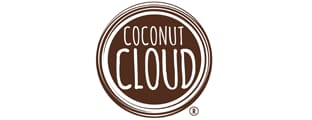





















 Table of Contents
Table of Contents




